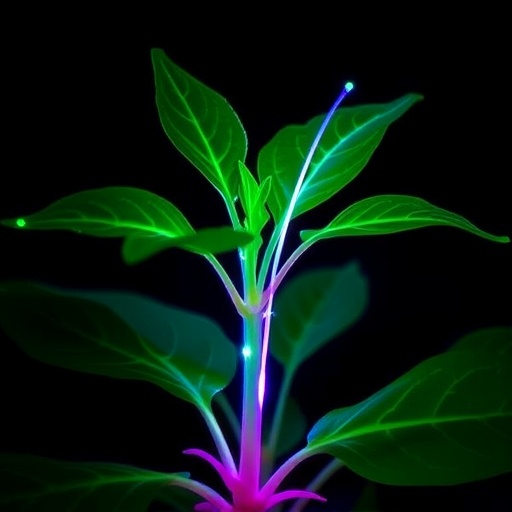In recent years, the impact of salt stress on plant health has emerged as a critical area of research, particularly in the context of global climate change and rising salinity in agricultural lands. Salinity poses a significant challenge to plant growth, affecting crop yield and agricultural productivity worldwide. In a groundbreaking study, researchers led by Ma, X., Zeng, X., and Huang, Y. have developed an innovative NaCl-responsive fluorescent probe that opens new avenues for understanding and visualizing how plants respond to salt stress. This advancement not only sheds light on the physiological mechanisms at play but also provides valuable tools for agricultural scientists aiming to develop salt-tolerant crop varieties.
At the heart of this study is the need to visualize salt-induced changes within plant tissues. Traditional methods of assessing plant stress are often invasive, destructive, or limited in their ability to capture real-time physiological responses. The NaCl-responsive fluorescent probe represents a significant advancement in this regard, offering non-invasive monitoring of salt stress in live plants. This method leverages cutting-edge fluorescent technology to provide researchers with insights into the plant’s stress response as it happens, enabling them to track changes dynamically over time.
The researchers designed this fluorescent probe to respond specifically to sodium chloride, a primary component of salt stress. When the probe encounters NaCl, a change in its fluorescence signature occurs, allowing scientists to monitor the concentration of salt stress within plant tissues. This real-time data acquisition is pivotal for understanding how plants perceive and respond to environmental stressors, particularly salinity. The ability to visualize these processes opens the door for further research into salt stress responses, potentially leading to the development of more resilient crop varieties.
One of the critical advantages of this NaCl-responsive probe is its specificity. By targeting NaCl, it avoids the confounding effects that other ions may have in plant tissues. This specificity is crucial for generating accurate data and understanding the precise mechanisms by which salt affects plant physiology. Furthermore, the researchers demonstrate that this probe can be adapted for various plant species, making it a versatile tool for plant biologists and agricultural researchers alike.
The study conducted by Ma and colleagues includes extensive testing across different plant species, including economically important crops. The probe’s performance has been validated in several species, showcasing its broad applicability. Such tests not only prove the utility of the probe but also highlight the differences in salt stress responses among various plant types. Understanding these nuances is vital for developing effective strategies for breeding and engineering salt-tolerant varieties.
Moreover, the implications of this probe extend beyond plant physiology. With an increasing global population and diminishing arable land, the need for crop varieties that can thrive in saline conditions is more urgent than ever. Addressing this agricultural challenge requires a multifaceted approach, which includes genetic research, agronomic practices, and now, the technological advancements provided by tools like the NaCl-responsive fluorescent probe. This research therefore represents a crucial step forward in addressing food security concerns on a global scale.
As science continues to unveil the intricacies of plant responses to stress, the implications of such research cannot be overstated. Understanding how plants adapt to saline conditions enhances our knowledge of their resilience mechanisms. It allows researchers to pinpoint which genetic traits are associated with salt tolerance, leading to more precise interventions in crop breeding. Such advances may empower farmers to cultivate crops in areas once deemed unsuitable for agriculture, increasing both the scope and diversity of food production.
In conclusion, the development of a NaCl-responsive fluorescent probe marks a pivotal moment in the field of plant science. This tool not only enhances our understanding of how plants cope with salt stress but also serves as a beacon of hope for future agricultural practices. By enabling real-time, non-invasive monitoring of salt stress, researchers are now better equipped to tackle one of the most pressing issues in modern agriculture. The work of Ma, Zeng, and Huang heralds an era where innovative tools and technologies can significantly enhance our efforts to secure a sustainable food future. As we strive to navigate the challenges posed by climate change and diminishing resources, such advancements will undoubtedly play a crucial role in shaping the future of agriculture.
The implications of this research reverberate beyond the laboratory. They signal a shift towards more precise agricultural practices that can address the specific needs of plants in adverse growing conditions. As the technology matures, we can expect further innovations that will provide even deeper insights into plant biology, paving the way for a more resilient agricultural landscape. The synergy between advanced materials, biology, and agricultural practice will be essential in meeting the global challenge of food security, especially in the face of increasing salinity and climate variability.
The researchers behind this groundbreaking development have emphasized that the true power of the NaCl-responsive fluorescent probe lies in its ability to foster collaborative research across disciplines. By offering a platform for real-time data collection and visualization, it encourages interdisciplinary partnerships among plant biologists, agronomists, chemists, and agricultural engineers. As these fields converge, the potential for innovation expands exponentially, driving forward a more comprehensive understanding of plant resilience mechanisms. The fusion of such diverse expertise will ultimately inform and catalyze the development of effective strategies for cultivating salt-tolerant crops.
Given the rapid pace of technological advancement, we expect that further iterations of this fluorescent probe will include additional functionalities that could enhance its utility. Future versions may integrate multi-stability mechanisms that allow for comparative studies between various stressors, such as drought and nutrient deficiency, alongside salinity. This holistic approach to plant stress visualization could lead to the creation of next-generation probes that provide a wealth of information regarding the interactions of different environmental factors affecting plant health.
As this research continues to evolve, it underscores the vital importance of fostering a scientific culture that embraces innovation and collaboration. The NaCl-responsive probe is not just a tool for measuring salt stress; it represents an invitation to rethink how we measure and respond to agricultural challenges. Through continued investment in research and development, we can ensure that these innovations translate into practical solutions for farmers and secure a more sustainable future for agriculture.
Salt stress is a complex and multifaceted phenomenon that necessitates a careful and nuanced understanding. The ability to visualize salt stress at the cellular level will be crucial for identifying markers of resilience that can be utilized in breeding programs aimed at enhancing crop tolerance to salinity. A deeper comprehension of these mechanisms holds the promise of significant agricultural advancements, particularly in regions that are increasingly suffering from salinization due to climate change, poor irrigation practices, and rising sea levels.
Together, the research led by Ma, Zeng, and Huang illustrates the extraordinary potential of using advanced fluorescent technologies to revolutionize plant sciences. By pushing the boundaries of traditional research methodologies, they are carving out a new frontier in agricultural technology that could greatly influence how we approach food production and cultivation in the face of global challenges. Their contributions signal the dawn of a new era in which scientific innovation and agricultural sustainability become inextricably linked.
In light of these developments, it is critical for stakeholders in the agricultural sector, including policymakers and educators, to support the integration of such technologies into practical applications. By prioritizing research that aligns with real-world agricultural problems, we can create a feedback loop that fosters continuous improvement and adaptation in our agricultural systems. The stakes have never been higher, and the success of future food systems depends on our ability to adapt and innovate. The NaCl-responsive fluorescent probe is a key step forward in achieving these goals.
Subject of Research: Plant salt stress visualization using NaCl-responsive fluorescent probe.
Article Title: Addendum: Visualizing plant salt stress with a NaCl-responsive fluorescent probe.
Article References:
Ma, X., Zeng, X., Huang, Y. et al. Addendum: Visualizing plant salt stress with a NaCl-responsive fluorescent probe.
Nat Protoc (2025). https://doi.org/10.1038/s41596-025-01280-3
Image Credits: AI Generated
DOI: 10.1038/s41596-025-01280-3
Keywords: salt stress, NaCl-responsive probe, plant physiology, salt tolerance, agricultural innovation.
Tags: agricultural salinity challengesfluorescent technology in agricultureinnovative agricultural research toolslive plant tissue analysisNaCl-responsive fluorescent probenon-invasive plant monitoring techniquesphysiological mechanisms of plant stressplant health and climate changeplant salt stress visualizationreal-time physiological response trackingsalt stress impact on crop yieldsalt-tolerant crop development





